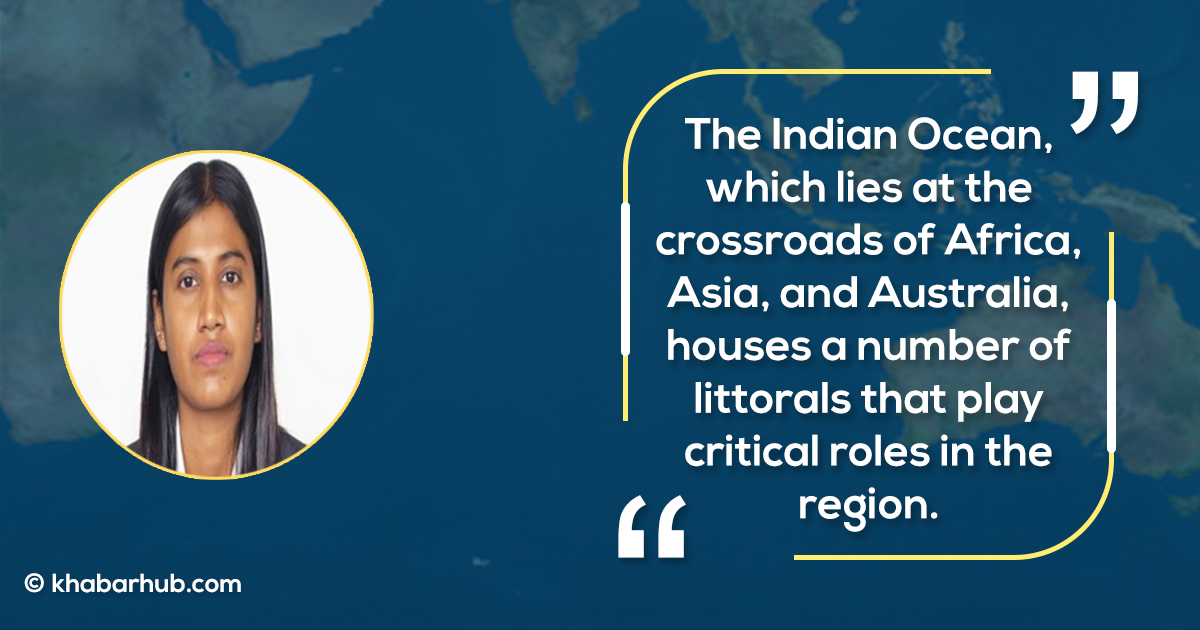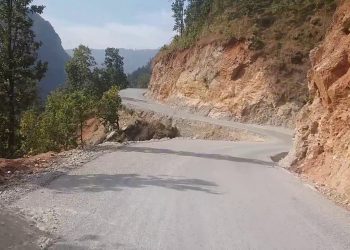The Indian Ocean has emerged as a critical conduit for trade, commerce, and energy. The waters of the Indian Ocean Region (IOR) have become a home for economic developments, disputes, conflicts, and competition for regional influence by regional and extraregional powers.
All major powers, such as the United States, Australia, Japan, United Kingdom, India, and China have sought stakes in the security of the IOR.
During the Cold War, the Soviet Union wanted direct access to the IOR; now, China is looking for the same. The India Ocean remains a pivot, being the world’s busiest trade route.
Around 80 percent of the world’s maritime oil trade passes through the IOR. The rise of China across the maritime region has compelled nations (including India) to reshape their maritime strategies.
This commentary aims at looking at the geostrategic importance of the IOR for India, China’s presence in the region, and counterbalance strategies.
Geostrategic Importance of the IOR
The Indian Ocean, which lies at the crossroads of Africa, Asia, and Australia, houses a number of littorals that play critical roles in the region.
The IOR is a vital sea lane with choke points such the Strait of Hormuz, Strait of Malacca, Bab-el Mandeb, and so forth.
These choke points are of immense strategic importance, as huge volumes of trade pass through them.
China has often enticed leaders from countries with unstable economies to allow Chinese investment in their territories. However, India has always dissented against the same on grounds of security concerns.
These choke points are exposed to piracy, international disputes, political dissents, and accidents.
To ward off such threats and to gain/maintain a strong foothold in this resource rich region, regional and external powers flex their muscles.
The islands in the Indian Ocean also work significantly to shape security architecture of the IOR.
These islands play a vital role along the sea lines of communication (SLOC) by giving easy access to navies continued presence and allowing them to patrol and secure SLOCs during the time of peace and war.
The Indian Ocean acts as an intersection for the transport of oil from the Middle East.
This is also the reason why external powers are trying to strengthen their footholds, making it a region for them to showcase their vigor and potentiality.
When talking about the geostrategic importance, “security dynamics” in the IOR play an equally pivotal role.
In the view of the same, the Persian Gulf in the Arabian Sea (northern Indian Ocean) also plays an equally important role for the security perspective of India.
The main aim of India in this area is to protect the SLOCs, which are laden with piracy threats in the Horn of Africa and the Red Sea.
The Indian Navy has warships deployed in the Gulf of Oman and Persian Gulf to provide safe passage for Indian-flagged vessels operating in the region.
India has also set up the Information Fusion Centre–Indian Ocean Region (IFC–IOR) to keep a close watch on the movement of ships in the region.
The IFC–IOR engages with partner nations to develop comprehensive maritime domain awareness and share information on vessels of interest.
Chinese Presence in the Backyard
The Chinese presence in the Indian Ocean remains a major concern across the region. Beijing is eager to have strong footholds in the IOR, Africa, and other island nations, through the Belt and Road Initiative (BRI).
The presence of China’s People’s Liberation Army Navy (PLAN) and other Chinese commercial vessels in the Indian Ocean, the Chinese interpretation of the United Nations Convention for the Law of the Sea, and so forth remain challenges to those who subscribe to the ideal of a free and open Indo-Pacific.
The geopolitical theory of the “String of Pearls” explains China’s potentials and intentions of establishing commercial and infrastructural projects in India’s backyard. China has invested in several projects from the Horn of Africa to the ASEAN nations and the Pacific Island nations.
The revival of the Chinese Maritime Silk Route can be seen through China’s investment in the port of Hambantota in Sri Lanka, which Beijing gained control of through debt-trap lending, and the development of Pakistan’s Gwadar Port as a part of China–Pakistan Economic Corridor (CPEC).
In the Maldives, China had financed the China–Maldives Friendship Bridge, linking Malé to the island of Hulhumale and Hulhule. It is the first sea-crossing bridge for the Maldives and could play a vital role in the island nation’s long-term economic development.
The Maldives has also leased an uninhabited island, Feydhoo Finolhu, to a Chinese enterprise for 50 years at a price of around 4 million USD, with plans to develop infrastructure for tourism.
Along the African coastal belt, one-quarter of all Chinese investment is concentrated in Nigeria and Angola. Nigeria has received relatively large funds from China for railways.
Abuja also hopes that China will support peacekeeping in the Niger Delta region, which would better secure oil investments there. Beijing is backing two major rail projects—one from Lagos to Kano and the other from Lagos to Calabar.
China’s ambitious BRI, a 1 trillion USD investment project, is aimed at infrastructural developments.
However, many have criticized Beijing’s promises to build roadways, railways, and ports to revive the trade route linking China to Asia, Africa, and Europe as based upon debt-trap lending that financially burdens comparatively weak economies, allowing China to essentially gain sovereignty over portions of these countries.
The CPEC, which is a BRI project, has been a great concern for India, as it passes through the Pakistan-occupied Kashmir.
India has also helped Victoria with ocean mapping to protect Seychelles exclusive economic zone and has donated aircraft and launched a radar project.
China has often enticed leaders from countries with unstable economies to allow Chinese investment in their territories. However, India has always dissented against the same on grounds of security concerns.
Counterbalancing the Dragon on the Seas
The Chinese dragon might be obstructing India on land, disputing New Delhi’s claim of the Line of Actual Control (LAC). However, Beijing’s predominant geopolitical strategy of the great game lies in the Indian Ocean, where China has engaged in massive infrastructure projects for some time now. To counter the rise of China, India needs to up its game in the maritime sphere. New Delhi has been increasing India’s military investments since the Modi government first came to power in 2014.
In the Bay of Bengal (BoB), India has modernized facilities in the Andaman Islands and at a base in Campbell Bay in the Nicobar Islands.
In 2019, an infrastructure development plan worth 56.5 billion INR aimed at allowing additional warships, aircraft, troops, and drones to be stationed in the Andaman and Nicobar Islands was finalized. On 24 January 2019, the Indian Navy commissioned the new naval station INS Kohassa in the BoB islands.
While there has been a lot of stir claiming that this upgrade was aimed at countering the Chinese expansion at the IOR, Ding Hao, deputy director of the Asian–African Military Affairs Office of the Foreign Military Studies Department of the Chinese People’s Liberation Army’s Academy of Military Sciences, said the Andaman and Nicobar Islands are overseas territories of the Dominion of India and that it is a normal move for the Indian military to establish military bases there.
Beijing has defended China’s moves in the IOR by stating that it aims for peace and stability in the region.
To counter the rise of China in the Indian Ocean, India needs to emerge as a strong maritime power, which would be possible with support from the island nations in the region.
India has recently undertaken infrastructure development projects with dual-use logistics facilities in Mauritius and Seychelles.
India aims to upgrade facilities on the Agaléga Islands of Mauritius. In 2015, India and Mauritius had signed a MoU to improve air and sea facilities at the Agaléga Island.
Naval Exercise MILAN, hosted by the Indian Navy and most recently held on 8 November 2019, was attended by delegates from 17 foreign navies.
Even though the Agaléga islanders know that construction of naval base would lead to their displacement, the Mauritian government have ignored this as they want India to continue routing its money through Mauritius, which is their largest source of FDI. India can take this to its advantage and get logistic helps from Mauritius as well.
The 87 million USD project has been awarded to two companies: Afcons Infrastructure Limited and Rail India Technical And Economic Services (RITES) Ltd., a Government of India enterprise.
As per a memorandum of understanding (MOU) signed in 2015 by Indian prime minister Narendra Modi and his Mauritian counterpart, India would set up infrastructure for improving air and sea connectivity.
Even though construction of the naval base would lead to the displacement of Agaléga Islanders, the Mauritian government is eager for India to continue routing its money through Mauritius, as it represents the nation’s largest source of foreign direct investment.
New Delhi can use this to India’s advantage to gain logistical assistance from Mauritius as well.
With Seychelles, India has agreed on developing infrastructure on Assumption Island. India has also helped Victoria with ocean mapping to protect Seychelles exclusive economic zone and has donated aircraft and launched a radar project.
However, it is also important to note that Mauritius and Seychelles, being the small islands that they are, may not align with India to the point of isolating China completely in the IOR.
The United States, on the other hand, can definitely provide India with logistics.
The Logistics Exchange Memorandum of Agreement (LEMOA) between Washington and New Delhi would enable India to gain logistical support from the many US facilities located throughout the Indo-Pacific.
In the wake of the COVID-19 pandemic, when the world order is expected to witness a geostrategic shift, India will aim at further strengthening its presence in the IOR.
India is a part of several bilateral and multilateral military exercises in the Indian Ocean. Naval Exercise MILAN, hosted by the Indian Navy and most recently held on 8 November 2019, was attended by delegates from 17 foreign navies.
The 2020 edition of the exercise has been postponed in the wake of COVID-19 pandemic but is expected to be the largest iteration of the exercise, with the projected participation of 30 foreign navies.
Exercise Malabar is a trilateral maritime event between India, Japan, and the United States and aims at strengthening cooperation and enhancing interoperability among participants. In 2020, India prepared to expand the grouping by including Australia as well.
Previously, India had been reluctant to invite Australia as it would appear to be connected to the Quadrilateral Security Dialogue (Quad), an informal strategic forum among these same four nations, aimed straightforwardly against the China’s rise.
However, given the June 2020 Sino-India clashes at the LAC in eastern Ladakh’s Galwan Valley, India is expected to make the decision of inviting Australia and in doing so enhance its strategic position vis-à-vis Beijing.
Military exercises in the IOR are significant due to the increasing Chinese threat. Separately, in June 2020, the Indian Navy increased its surveillance and operational deployment in the IOR, with the Galwan clash as a backdrop.
The Indian Navy also held an important exercise with its Japanese counterparts in the IOR, where Chinese naval vessels and submarines make persistent incursions.
The Indian Ocean will remain one of the world’s most strategic locations, with more than 75 percent of the world’s maritime trade and 50 percent of daily global oil transfers passing through the region.
China’s ventures in the IOR are seen as one of the most vital reasons for the Indian Navy to assert its preparedness to ward off security threats in the region.
Conclusion
As a move to strengthen itself at the IOR, India has increased its military capacity from operating only in the neighborhood to operating in the entire region—from the Malacca Strait to the waters off the African coasts.
In the wake of the COVID-19 pandemic, when the world order is expected to witness a geostrategic shift, India will aim at further strengthening its presence in the IOR.
In this dynamic, India will look forward to building up the gambit with Indian Ocean littorals such as Sri Lanka, Maldives, Mauritius, and Seychelles to scrutinize the rise of China.
India is also likely to develop a strategic plan with the United States, without overtly professing such measures as “anti-Chinese moves.”
The Indian Ocean will remain one of the world’s most strategic locations, with more than 75 percent of the world’s maritime trade and 50 percent of daily global oil transfers passing through the region.
As a result, India’s primary aim will be to maintain a stable and peaceful India Ocean, with a focus toward economic and military alterations obviating the menacing Chinese threat.
(Priyanjoli Ghosh works as a risk analyst. She focuses on politics and geopolitics and has worked on business continuity plans for clients in the oil and energy sector, professional services, insurance providers, and IT sector)
(The Air Force Journal of Indo-Pacific Affairs (JIPA) — United States’ Air Force and Khabarhub — Nepal’s popular news portal, have agreed on a sole partnership to disseminate JIPA research-based articles from Nepal)









Comment